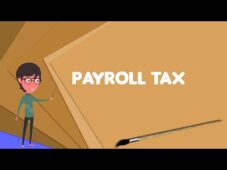Content

The $5,250 cap applies to both the new student loan repayment benefit and educational assistance under Section 127 of the Internal Revenue Code . As amended, the provision applies to any student loan payments made by an employer on behalf of an employee after date of enactment and through 2025 . Pharmacies will typically fill out the tab titled “Hospital_Ancillary_Clinic”. If the “Hospital_Ancillary_Clinic” tab is completed, individual pharmacists do not need to be listed on the provider roster. If a pharmacy’s National Provider Identifier is assigned per service location and claims are billed at this level, the provider should complete the “Hospital_Ancillary_Clinic” tab and fill out one row per taxpayer identification number /NPI/service location. Eligible providers began enrolling in the program on April 27, 2020, and submitting claims on May 6, 2020.
$200 million to support COVID-19 infection control in skilled nursing facilities and $250 million for “strike teams” to assist skilled nursing facilities, funding will be provided until one year after the end of the public health emergency. Clarifies that secretary of health and human services must require quality improvement organizations to provide support to skilled nursing facilities and add vaccination uptake support as a part of required activities. The LEAs must reserve at least 20% of the funding they receive to address learning loss. Remaining funds are flexible and can address a variety of needs, including repairing ventilation systems, reducing class sizes and implementing social distancing guidelines, purchasing personal protective equipment, and hiring support staff to care for students’ health and well-being. School districts will be required to create and share plans publicly for returning to in-person instruction within 30 days. The Treasury Department could provide payments to individuals who have not filed based on return information available to the department.
What services are eligible for reimbursement?
Consequently, Cares Act And Ffcra Provisions Expirings are entitled to a tax credit of up to 12 weeks of EFMLEA under the ARPA. The tax credit per employee remains unchanged and is limited to two-thirds of an employee’s regular rate of pay up to a maximum of $200 per day for all of the six expanded reasons listed above. The ARPA does not clearly provide whether the 12 weeks of leave resets after April 1, 2021, however. Covered employers under the FFCRA qualified for dollar-for-dollar tax credits on amounts paid to employees taking leaves for qualifying reasons . Under this framework, tax credits also extended to amounts paid or incurred to maintain health insurance coverage. The paid sick leave and tax credit benefit provisions under the FFCRA were in effect between April 1, 2020 and December 31, 2020.

States that miss the deadline would have to pay back any undistributed funds. A town cannot receive more than 75% of its budget as of Jan. 27, 2020. The Treasury Department could also withhold up to half of a state or territory’s allocation for as long as 12 months based on its unemployment rate and require an updated certification of its funding needs. A covered employee may apply, however, for SDI after taking the 2021 COVID-19 Supplemental Paid Sick Leave to which the covered employee is entitled. The Employment Development Department administers SDI, which provides benefits that are approximately 60‑70 percent of wages for eligible employees who are unable to work because they are sick or subject to an isolation or quarantine order or guideline.
Congress Extends FFCRA Tax Credit into 2021, Declines to Extend FFCRA Leave
Deferred tax amounts would be paid over two years, in equal amounts due on December 31, 2021 and December 31, 2022. Excludes wages paid for which the employer receives a Work Opportunity Tax Credit . For any new codes where a CMS published rate does not exist, claims are held until CMS publishes corresponding reimbursement information. Since the primary reason for treatment was cancer and not COVID-19, the cancer treatment is not eligible for reimbursement.

$28.6 billion for restaurants, bars, and other eligible providers of food and drink. Provides $100 million via the Emergency Management Performance Grants to state and local emergency management agencies to help communities address COVID-19 and facilitate vaccine rollout. Directs the President to provide disaster-related funeral expenses to individuals and households at 100% federal cost share. For 2021 and 2022, eliminates insurance premiums for individuals at 150% of FPL or less and reduces insurance premiums for all other households.
Families First Coronavirus Response Act (FFCRA)
In contrast, the second business where you are placed will generally be required to provide its employees with paid sick leave or expanded family and medical leave because it has fewer than 500 employees . For example, if you are prohibited from leaving a containment zone and your employer remains open outside the containment zone and has work you cannot perform because you cannot leave the containment zone, you may take paid leave under the FFCRA. Similarly, if you are ordered to stay at home by a government official for fourteen days because you were on a cruise ship where other passengers tested positive for COVID-19, and your employer has work for you to do, you are also entitled to paid sick leave if you cannot work because of the order. If, however, your employer closed one or more locations because of a quarantine or isolation order and, as a result of that closure, there was no work for you to perform, you are not entitled to leave under the FFCRA and should seek unemployment compensation through your State Unemployment Insurance Office. How do I compute the number of hours I must pay my employee who has irregular hours for each day of expanded family and medical leave taken?
- The retroactive payment by the employer pays the covered employee the amount required under the 2021 COVID-19 Supplemental Paid Sick Leave law (see FAQs 12-15).
- But employers could still voluntarily choose to provide FFCRA paid sick or paid family leave to employees and receive refundable tax credits for costs related to providing the leave through March 31, 2021.
- However, you are entitled to paid sick leave under the Emergency Paid Sick Leave Act regardless of how much leave you have taken under the FMLA.
- For advanced capabilities, workforce management adds optimized scheduling, labor forecasting/budgeting, attendance policy, leave case management and more.
- However, the employer may satisfy its obligations under both Acts by other means, provided they are consistent with its bargaining obligations and collective bargaining agreement.
If your leave of absence is voluntary, you may end your leave of absence and begin taking paid sick leave or expanded family and medical leave under the FFCRA if a qualifying reason prevents you from being able to work . However, you may not take paid sick leave or expanded family and medical leave under the FFCRA if your leave of absence is mandatory. This is because it is the mandatory leave of absence—and not a qualifying reason for leave—that prevents you from being able to work .
The definition of qualified wages also depends, in part, on the average number of full-time employees employed by the eligible employer during 2019. The program reimburses providers for COVID-19 testing, treatment, or vaccine administration fees for uninsured individuals; therefore, any money collected from the individual must be returned to the individual if the provider received funding for that patient through this program. The testing-related visit is not eligible for reimbursement because the care setting is not an office visit, telehealth visit, urgent care or emergency room and is not separately billable with applicable CPT/HCPCS codes on the inpatient claim. Unless COVID-19 is the primary diagnosis for the admission, no portion of this claim is eligible for reimbursement under the program given the primary reason for treatment is not COVID-19. The CARES Act created a new category of “coronavirus-related distributions” and loans from retirement plans of up to $100,000, which were not subject to early distribution taxes under IRC Section 72. For coronavirus-related distributions, the CARES Act allowed income to be spread ratably over three years and allowed repayment to another eligible retirement plan within the same three-year period.
Do you get paid for sick days when you quit in California?
No, not unless your employer's policy provides for a payout. If you leave your job and get rehired by the same employer within 12 months, you can reclaim (restore) what you had accrued in paid sick leave, provided it was not paid out pursuant to a paid time off policy at termination.
https://adprun.net/s may choose to exclude health care providers and emergency responders from paid leave under the FFCRA. Contact your human resources department if you are unsure if the FFCRA applies to your employer. The EPSLA and Expanded FMLA requires certain government employers and private employers with fewer than 500 employees to provide paid sick and family leave, respectively, to employees unable to work or telework for periods after March 31, 2020, and before January 1, 2021. The COVID-related Tax Relief Act of 2020 amended the FFCRA to extend the period for which Eligible Employers may provide paid sick and family leave to employees after December 31, 2020 and claim tax credits. Specifically, Eligible Employers that voluntarily provide paid sick or family leave to employees that otherwise would have met the requirements of the EPSLA or Expanded FMLA may claim the tax credits for providing the paid leave through March 31, 2021.
Does summer vacation count as a school closure?
Can I take paid sick leave to care for any individual who is subject to a quarantine or isolation order or who has been advised to self-quarantine? You may take paid sick leave under the FFCRA to care for an immediate family member or someone who regularly resides in your home. You may also take paid sick leave under the FFCRA to care for someone where your relationship creates an expectation that you care for the person in a quarantine or self-quarantine situation, and that individual depends on you for care during the quarantine or self-quarantine. But if you are a Federal employee, you likely are not entitled to expanded family and medical leave. The Act only amended Title I of the FMLA; most Federal employees are covered instead by Title II of the FMLA.
Millions Could Soon Lose Medicaid Coverage – Seattle Medium
Millions Could Soon Lose Medicaid Coverage.
Posted: Mon, 20 Mar 2023 15:55:11 GMT [source]
However, any worker who has been misclassified as an independent contractor but is in fact an employee, and otherwise qualifies under the new law, is entitled to 2021 COVID‑19 Supplemental Paid Sick Leave. EFML is an expansion of the benefits provided under the traditional Family and Medical leave Act . Though the expansion of these credits is currently set to expire after 2021, they are a central piece of President Biden’s Build Back Better agenda, and we may see their renewal in the pending budget reconciliation. In addition, both the CARES Act and CAA suspend the 60% charitable contribution deduction limitation for qualified cash contributions in 2020 and 2021, allowing taxpayers to offset up to 100% of their current-year adjusted gross income via itemized charitable contribution deductions.

